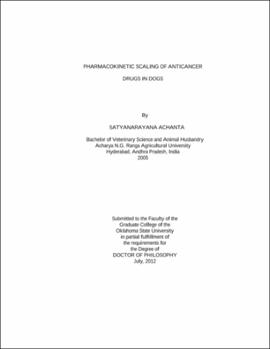| dc.contributor.advisor | Maxwell, Lara K. | |
| dc.contributor.author | Achanta, Satyanarayana | |
| dc.date.accessioned | 2013-11-26T08:35:10Z | |
| dc.date.available | 2013-11-26T08:35:10Z | |
| dc.date.issued | 2012-07 | |
| dc.identifier.uri | https://hdl.handle.net/11244/7645 | |
| dc.description.abstract | Scope and Method of Study: Anticancer drugs are characterized by a narrow therapeutic index and wide inter-individual variability in therapeutic outcome, disposition, and toxicity. The accurate calculation and administration of anticancer drugs from the initiation of treatment is necessary to attain a good therapeutic outcome. Currently, the doses of anticancer drugs are calculated based on the body surface area approach, which requires prior dose escalation studies to establish the maximum tolerated dose. In addition, several studies have questioned the ability of standard dosing methods to adequately normalize drug exposure for several anticancer drugs. As with most drugs, the efficacy of anticancer drugs correlates best with total drug exposure, or the area under the plasma concentration versus time curve. If the clearance of a drug is accurately known, then the dose required to produce a desired total drug exposure can be calculated accordingly. Therefore, it is important to understand the factors that influence the clearance of a drug. Physiological based pharmacokinetic (PBPK) modeling can predict absorption, distribution, metabolism, and excretion of a drug by consideration of anatomical, physiological, and pharmacokinetic parameters. We hypothesized that the concomitant consideration of the effects of body weight and ontogeny on organ physiology and drug handling will accurately predict the clearance of several model anticancer drugs. In order to test our hypothesis, organ and body weights were collected from 383 dogs, in vivo physiological and pharmacokinetic studies of vinblastine and cisplatin disposition were conducted in ten intact male dogs (4 - 54 kg), and in vitro drug metabolism studies of vinblastine were conducted. The overall objective of this project was to determine the clearance of model anticancer drugs in order to optimize the drug exposure of anticancer drugs among disparate canine patients. | |
| dc.description.abstract | Findings and Conclusions: Heart, liver, and kidney weights were allometrically related to body weight. The newly developed allometric equations better predicted organ weights than did the established, fixed proportion of body weight approach. In contrast to previous studies, the clearance of cisplatin correlated well with glomerular filtration rate (GFR), suggesting that initial doses of cisplatin were directly related to GFR in healthy dogs. A highly sensitive liquid chromatography/tandem mass spectrometry analytical method was developed to quantify the concentrations of vinblastine and its putative metabolite, desacetylvinblastine, in plasma and urine samples of dogs. The predicted in vitro hepatic clearance of vinblastine was within 10% of measured in vivo values. The use of in vitro/in vivo correlations of drugs may reduce the number of live animal studies needed for dose calculations of novel anticancer drugs. Further, the newly developed allometric equations of organ weights, physiological, and pharmacokinetic parameters can be used as data for input into PBPK models. | |
| dc.format | application/pdf | |
| dc.language | en_US | |
| dc.rights | Copyright is held by the author who has granted the Oklahoma State University Library the non-exclusive right to share this material in its institutional repository. Contact Digital Library Services at lib-dls@okstate.edu or 405-744-9161 for the permission policy on the use, reproduction or distribution of this material. | |
| dc.title | Pharmacokinetic scaling of anticancer drugs in dogs | |
| dc.contributor.committeeMember | Bourne, David W. A. | |
| dc.contributor.committeeMember | Ritchey, Jerry W. | |
| dc.contributor.committeeMember | Wagner, Jarrad R. | |
| osu.filename | Achanta_okstate_0664D_12340.pdf | |
| osu.accesstype | Open Access | |
| dc.type.genre | Dissertation | |
| dc.type.material | Text | |
| dc.subject.keywords | anticancer drugs | |
| dc.subject.keywords | cisplatin | |
| dc.subject.keywords | dogs | |
| dc.subject.keywords | in vitro / in vivo | |
| dc.subject.keywords | pharmacokinetics | |
| dc.subject.keywords | vinblastine | |
| thesis.degree.discipline | Veterinary Biomedical Sciences | |
| thesis.degree.grantor | Oklahoma State University | |
